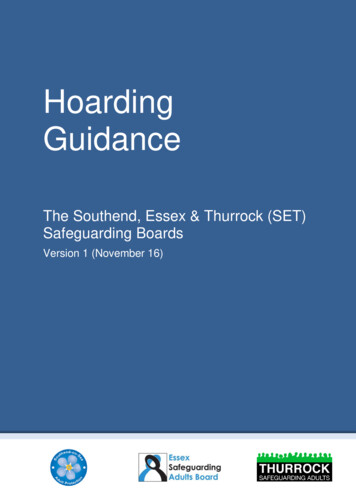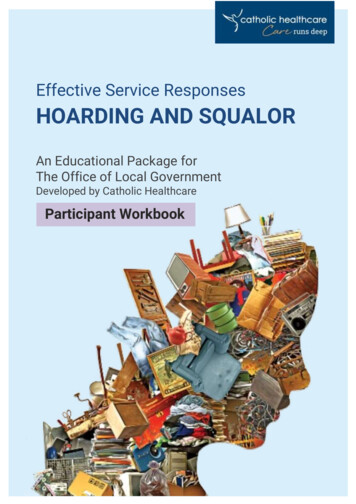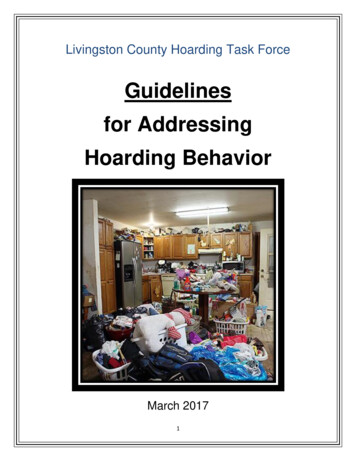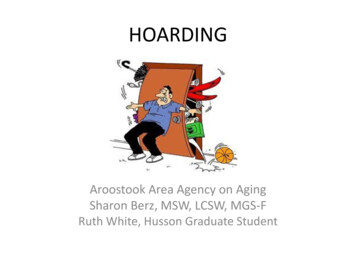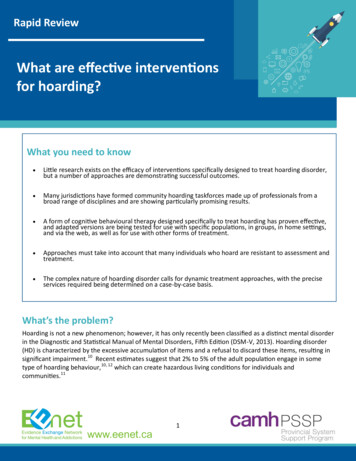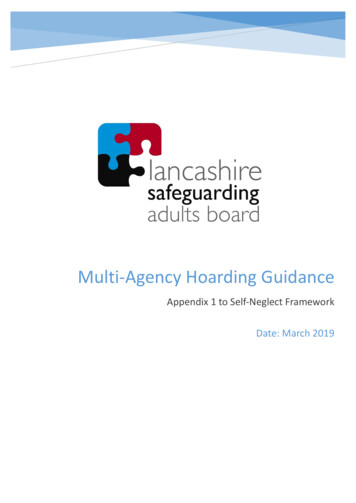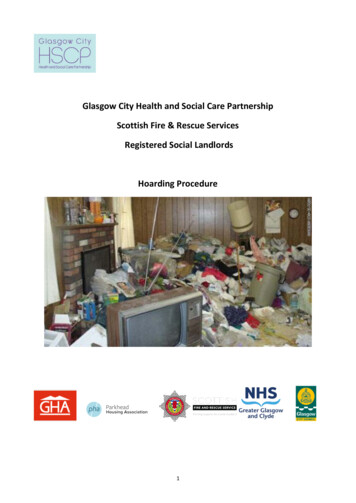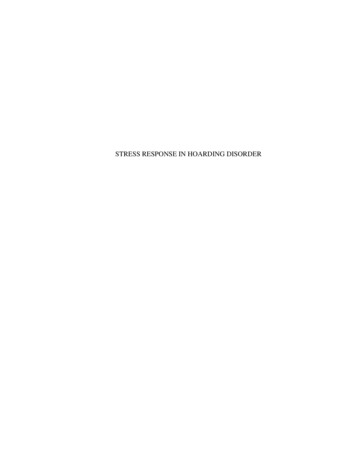
Transcription
STRESS RESPONSE IN HOARDING DISORDER
STRESS RESPONSE IN INDIVIDUALS DIAGNOSED WITH HOARDINGDISORDERBy ATAYEH HAMEDANI, B.A.A Thesis Submitted to the School of Graduate Studies in Partial Fulfilment of theRequirements for the Degree Master of ScienceMcMaster University Copyright by Atayeh Hamedani, August 2014
McMaster University MASTER OF SCIENCE (2014) Hamilton, Ontario (Neuroscience)Title: Stress Response in Individuals Diagnosed with Hoarding Disorder AUTHOR: AtayehHamedani, B.A. (McMaster University) SUPERVISOR: Dr. R. McCabe NUMBER OF PAGES:vii, 71i
AbstractHoarding disorder (HD) is characterized by (a) the acquisition of and inability to discard a largenumber of possessions; (b) clutter that interferes with the use of appliances and general livingareas in the home; and (c) clinically significant distress or impairment in functioning. Althoughprevious studies have reported that individuals with HD exhibit emotional dysregulation whendiscarding personal items, this investigation is the first to examine the biological indices ofdistress. The current study aimed to examine whether individuals with HD differed from healthycontrols in their psychological and biological responses to a general psychosocial stressor and toinvestigate whether individual differences in stress response relate to differences in symptomseverity and impairment. Twenty-one individuals with HD and 22 healthy controls (CTLs)completed the Trier Social Stress Task and self-reported affect and salivary cortisol responses tothe stressor were assessed. Individuals with HD did not significantly differ compared to CTLs intheir salivary cortisol levels in relation to the stressor. However, individuals with HD significantly differed compared to CTLs in their subjective levels of distress in relation to the stressor. Contrary to our hypotheses, responses to stress were not significantly correlated with measures ofsymptom severity and impairment due to hoarding. The current findings indicate that individualswith HD exhibit a greater self-reported emotional response to a general stressor. The implications of these findings are discussed.ii
AcknowledgementI would like to thank my supervisors Dr. Randi E. McCabe and Dr. Joelle LeMoult for theirsupport, patience and guidance throughout my masters. Despite their many academic andprofessional commitments, they always made time to address my concerns. Their knowledge andcommitment to research inspired and motivated me. It is to them that I owe my deepest gratitude.In addition, I would like to thank the wonderful staff at the Anxiety Treatment & ResearchCentre, St. Joseph’s Healthcare for their encouragement and support. I would like toacknowledge Dr. Karen Rowa for her valuable feedback with regard to research design andparticipant recruitment. I would like to express my sincerest gratitude to my family, who havealways supported, encouraged and believed in me. Finally, I am thankful for the invaluablefeedback and guidance of Dr. Margaret McKinnon and Dr. Geoffrey Hall.iii
Table of ContentsIntroduction . 1Overview of Hoarding Disorder . 1Diagnostic Criteria . 2Diagnosis and Assessment of Hoarding Disorder . 5Cognitive Behavioral Model of Hoarding . 9Emotion Dysregulation .11Assessing Responses to Stress . 15Current Study . 17Methods. 18Participants . 18Measures . 19Procedures . 23Results . 24Discussions . 29References . 39iv
List of Tables and FiguresFigure 1. Trier Social Stress Test and Measures of Stress Response . 55Figure 2. Negative Affect Ratings Over Time . 56Figure 3. Changes in Salivary Cortisol over Time . 57Table 1.Demographic and Symptom Information . 58Table 2. Means and Standard Deviations for Clinical Measures . 59Table 3. Change Scores ( ), Negative Affect . 60Table 4. Area Under the Curve (AUCG) . 61Table 5. Pearson-Product Correlation (two-tailed), for AUCG . 62v
List of all Abbreviations and SymbolsACTH: adrenocorticotropic hormoneACC: Anterior Cingulate CortexADHD: Attention Deficit/Hyperactivity DisorderADL-H: Activities of Daily Living in HoardingANOVA: Analysis of VarianceAPA: American Psychiatric Association AS: Anxiety SensitivityAUCG: Area under the curve with respect to groundCBT: Cognitive Behavioural TherapyCIR: Clutter Image RatingCRH: Corticotrophin-releasing hormoneCTL: ControlDASS: Depression Anxiety Sensitivity ScaleDERS: Difficulties in Emotion Regulation ScaleDSM: Diagnostic and Statistical Manual of Mental DisordersDT: Distress ToleranceGAD: Generalized Anxiety DisorderHD: Hoarding DisorderHPA: Hypothalamic-pituitary adrenalHRS-I: Hoarding Rating Scale-InterviewIIRS: Illness Intrusiveness Rating ScaleM: MeanMDD: Major Depressive DisorderNA: Negative AffectOCD: Obsessive-Compulsive DisorderOCI-R: Obsessive-Compulsive Inventory- RevisedOCPD: Obsessive-Compulsive Personality DisorderPANAS: Positive and Negative Affect ScalePD: Panic DisorderPTSD: Post-traumatic Stress DisorderRM-ANOVA: Repeated Measure-Analysis of VarianceSAD: Social Anxiety DisorderSCID: Structured Clinical Interview for DSM-IV Axis I DisordersSD: Standard deviationSE: Standard errorSIHD: Structured Interview for Hoarding DisorderSI-R: Savings Inventory-RevisedTSST: Trier Social Stress Test : Changevi
Declaration of Academic AchievementI hereby certify that the material presented in this thesis towards completion of a Masters (M.Sc.)degree in the McMaster Integrative Neuroscience Discovery and Study program, at McMasterUniversity, Hamilton, Ontario is exclusively my own work and has not been submitted to anyacademic assessment other than partial-fulfillment of the degree named above.vii
Master’s Thesis - A. Hamedani; McMaster University - Neuroscience.IntroductionOverview of Hoarding DisorderHoarding disorder (HD) is a newly established disorder in the American PsychiatricAssociation’s (APA) Diagnostic and Statistical Manual of Mental Disorders (DSM) (APA, 2013);it is included under an equally new Obsessive-Compulsive and Related Disorders section. Alongwith HD, this section includes body dysmorphic disorder, trichotillomania (hair pullingdisorder), and excoriation (skin picking disorder). HD was primarily included in this section dueto similarities between HD and other obsessive-compulsive and related disorders. However, HDalso shares features with disorders such as attention deficit and hyperactivity disorder (Tolin &Villavicencio, 2011), which are located in the Neurodevelopmental Disorders section of theDSM-5. As research on this debilitating disorder increases over time, it will help further refinethe most appropriate section that it should be contained in.In previous editions of the DSM, specifically the fourth edition of the DSM (APA, 2000),the “inability to discard worn-out or worthless objects even when they have no sentimentalvalue” was one of eight diagnostic criteria for obsessive-compulsive personality disorder(OCPD). The differential diagnosis section of OCPD further stated: “A diagnosis of obsessivecompulsive disorder (OCD) should be considered especially when hoarding is extreme” (p. 728).Therefore, although hoarding was not explicitly mentioned in the OCD section, when hoardingwas considered severe it was a symptom of OCD. However, extensive research over the pastdecade conducted on hoarding cases has exemplified that the majority of individuals withhoarding symptoms do not meet diagnostic criteria for either OCD or OCPD (Frost, Steketee, &Tolin, 2011; Frost, Steketee, Williams, & Warren, 2000; Hall, Tolin, Frost & Steketee, 2013). Infact, recent research also suggests that HD is neurobiologically different from OCD (Saxena,2008; Saxena et al., 2004).1
Master’s Thesis - A. Hamedani; McMaster University - Neuroscience.Diagnostic CriteriaIn the current edition of the DSM (DSM-5; APA, 2013), HD has six criteria that must bemet for a diagnosis. This includes two exclusion criteria, which are used to rule out otherpotential causes for hoarding behavior.Criterion A. This criterion focuses on the primary feature of hoarding, the inability topart with possessions regardless of their actual value. Individuals struggle with any attempt atparting with items, which includes donating, recycling, or selling (Frost, Steketee, & Tolin,2012). It is important to note that difficulty must be persistent in order to differentiate fromtemporary life circumstances (i.e., inheriting a large number of items). Items that are mostcommonly collected include: newspapers, magazines, bags, books, clothing, and paperwork(Pertusa et al., 2008). Although it may seem that accumulated possessions are worthless or wornout, in fact, collected items are usually a mix of valuable as well as worthless items (Frost,Steketee, & Tolin, 2012). It is for this reason that the criterion specifically states, “regardless ofactual value.” Rarely, items such as animals, bodily products or rotten food can be hoarded. Theprimary reasons that individuals with HD are unable to discard possessions fall into three broadcategories: (1) the item is useful or valuable, (2) the item has intrinsic value, due to its aestheticqualities, or (3) there is emotional attachment to the item because it is related to a significantperson, time, event, or place (Frost, Hartl, Christian, & Williams, 1995). However, someindividuals also report saving due a sense of responsibility for items (Steketee, Frost, & Kyrios,2003). For example, an individual with HD may not want to waste an item that can still be usedor may experience significant guilt when discarding. Another reason that individuals with HDstruggle with discarding is due to a fear of losing information; individuals believe that discardingitems would result in losing the memories associated with that item (Hartl et al., 2004).Criterion B. This criterion helps differentiate hoarding behavior from other forms of2
Master’s Thesis - A. Hamedani; McMaster University - Neuroscience.psychopathology, passive collecting, or accumulating. Individuals with HD intentionallyaccumulate possessions and experience extreme distress when discarding. This behavior is verydifferent from normative collecting, and simple messiness or laziness. Hoarding behavior is alsodistinct from other forms of psychopathology that result in passive accumulation of items (seeCriterion E).Criterion C. This criterion pertains to clutter in active living spaces, due to difficultydiscarding, that inhibit their intended use. If living spaces are uncluttered, it is due to the effortsof third parties. It is important to note that clutter must prevent the use of active living areas. Thisaids in differentiating clutter in basements and garages (i.e., inactive living areas) that might becluttered in the majority of individuals not meeting diagnostic criteria, versus clutter in thekitchen or bedroom (i.e., active living areas). Clutter is defined as a large group of unrelated ormarginally related items piled together in a disordered fashion, which inhibits the use of theliving space (Steketee & Frost, 2003). Clutter must substantially inhibit the use of living areas.For example, the individual might not be able to take a shower, use the kitchen to cook, or sleepon their bed. In circumstances where living areas have been cleared due to the interference offamily members, partners, or even the local authorities; individuals can still meet this diagnosticcriteria because their living spaces are likely to become cluttered again.Criterion D. This criterion pertains to the distress or impairment caused by hoardingsymptoms (i.e., clutter/difficulty discarding). This criterion specifies that hoarding symptomsmust cause clinically significant distress or impairment in a number of important areas offunctioning. It is important to note that individuals with low insight will not report distress orimpairment due to hoarding symptoms. The inability to discard and resulting clutter will severelyinterfere with normal activities such as cooking, cleaning, and personal hygiene (Grisham,Brown, Savage, Steketee, & Barlow, 2007; Kim, Steketee, & Frost, 2001). Hoarding3
Master’s Thesis - A. Hamedani; McMaster University - Neuroscience.significantly affects an individual’s quality of life (Saxena et al., 2011), and family relationships(Tolin, Frost, Steketee, Gray, & Fitch, 2008).Criterion E. This criterion allows the clinician to rule out other potential causes ofhoarding. In order to meet diagnostic criteria, hoarding behavior cannot be a direct consequenceof another medical condition, such as a brain tumor, cerebrovascular disease, brain injury, or arare genetic condition (i.e., Prader-Willis syndrome). Individuals who acquire a brain injury tothe anterior ventromedial prefrontal and cingulate cortices, will begin to accumulate items afterthe injury (Mataix-Cols, Petusa, & Snowdon, 2011).Criterion F. This criterion is the second exclusion criteria, which allows clinicians to ruleout other potential causes of hoarding behavior, such as another form of psychopathology. HDshould not be diagnosed if it is a consequence of a neurodegenerative disorder (i.e., Alzheimer’sdisease). In these individuals, hoarding behavior follows the onset of the neurocognitive disorder.Similarly, HD should not be diagnosed if the behavior is a consequence of a neurodevelopmentaldisorder (i.e., autism spectrum disorder), due to symptoms or delusions in schizophrenia, loss ofenergy to clean up in major depression, or symptoms of OCD (i.e., fear of harm, or feelings ofincompleteness) (Mataix-Cols et al., 2010; Pertusa, Frost, & Mataix-Cols, 2010).Specifiers. DSM-5 criteria includes two specifiers: Excessive Acquisition and Insight.The Excessive Acquisition specifier refers to excessive buying, collecting, or stealing of itemsthat the individual does not need, have available space for, or cannot afford. Acquisition must bein excess, and directly impair functioning. This behavior is welcomed by the individuals, whofind gratification and comfort in acquiring. Approximately 75% of individuals engage inexcessive or compulsive buying, and over half acquire free things in excess (Frost, Tolin,Steketee, Fitch, & Selbo-Bruns, 2009). A number of studies have reported significant correlationsbetween acquisition and symptoms of psychopathology. In a recent study by Reid and colleagues4
Master’s Thesis - A. Hamedani; McMaster University - Neuroscience.(2011), high acquisition scores on the Savings Inventory- Revised (SI-R; Frost, Steketee, &Grisham, 2004) were significantly correlated with measures of social phobia, OCD, depressionand worry in a non-clinical sample. In a clinical sample, high acquisition scores on the SI-R wereassociated with OCD symptoms, positive and negative affect (Frost, Steketee, & Grisham, 2004),as well as anxiety, stress, and depression (Frost, Rosenfield, Steketee, & Tolin, 2013). Therefore,it is important to measure excessive acquisition in HD as it may influence responses to stress(e.g., negative affect) and be associated with symptoms of other anxiety disorders. The secondspecifier is Insight, which has clinical implications for seeking treatment, as well as adherence totreatment programs (Tolin, Fitch, Frost, & Steketee, 2010). It is important to note that individualswho seek treatment and volunteer for research studies have reasonably good insight. The Insightspecifier includes three categories to correctly capture the level of insight. It focuses on anindividual’s awareness of hoarding symptoms and resulting impairment. More than half offamily members of people who hoard described their hoarding family member as having poorinsight or lacking insight/delusional. Low levels of insight may also contribute to the poortreatment compliance commonly observed in patients with HD (Frost, Tolin, & Maltby, 2010).Low insight in HD remains a challenging feature for clinicians and family members.Diagnosis and Assessment of Hoarding DisorderThe diagnosis and assessment of HD requires a comprehensive and multimethodapproach due to its complex and multifaceted nature. In the past, clinicians and researchers haverelied heavily on the hoarding subscales in existing measures of OCD (e.g., ObsessiveCompulsive Inventory; Foa, Kozak, Salkovskis, Coles, Amir, 1998). However, after a decade ofresearch on HD, several measures have been developed to aid in diagnosis and assessment ofsymptom severity. The Savings Inventory-Revised (SI-R; Frost, Steketee, & Grisham, 2004) isone of the most widely used measures for HD. The SI-R is a self-report questionnaire with three5
Master’s Thesis - A. Hamedani; McMaster University - Neuroscience.subscales: clutter, difficulty discarding, and acquisition. As presented in Table 2, cut-off scoresand clinical means have been established for total and subscale scores (see Tolin, Frost, &Steketee, 2010). The SI-R is able to reliably distinguish between individuals with hoardingproblems and both non-hoarding OCD and controls (Frost, Steketee, & Grisham, 2004).Furthermore, the SI-R has been translated into 6 different languages, which reflect theapplicability of the measure. In an effort to circumvent low insight in individuals with HD, Frostand colleagues (2008) developed the Clutter Image Rating (CIR; Frost, Steketee, Tolin, &Renaud, 2008). The CIR consists of nine standardized photographs that show various stages ofclutter in different active living areas (i.e., bedroom, living room, and kitchen), respondents areasked to select the image that most closely resembles their homes. As many individuals with HDfail to recognize their behavior as problematic, selecting a picture instead allows for a less biasedreporting. The CIR has good psychometric properties and is sensitive to treatment effects (Frost,Pekareva-Kochergina, & Maxner, 2011; Tolin, Frost, & Steketee, 2007). In addition to self-reportmeasures, it is important to include interview-based assessments of hoarding symptoms. Onecommonly used semi-structured interview is the Hoarding Rating Scale-Interview (HRS-I; Tolin,Frost, & Steketee, 2010), which is comprised of five items to assess clutter, difficulty discarding,excessive acquisition, and the degree of impairment and distress due to hoarding. This measurehas demonstrated good discrimination between hoarding and OCD patients. In addition to theHRS-I, another well-validated semi-structured interview is the Structured Interview for HoardingDisorder (SIHD; Nordsletten et al., 2013). This measure is based on the provisional DSM-5criteria for HD. This measure contains questions pertaining to clutter, difficulty discarding,acquisition, and distress/interference. The SIHD also contains questions to help rule outalternative diagnoses (i.e., OCD and Autism-Spectrum Disorder), as well as general medicalconditions that would account for hoarding symptoms. To assess for HD specifiers, the SIHD6
Master’s Thesis - A. Hamedani; McMaster University - Neuroscience.also includes questions to assess excessive acquisition and low insight.As hoarding often occurs comorbid with other Axis I and Axis II diagnoses or symptoms,measures assessing commonly occurring anxiety and mood disorders should be included forclinical treatment and research purposes. Frost and colleagues (2011) reported that in a largecommunity sample of 217 individuals, the most prevalent comorbid condition was majordepressive disorder (MDD) with over half of the sample receiving this diagnosis. Whereas,generalized anxiety (GAD) and social anxiety disorder (SAD) occurred less frequently in thissample, with only one quarter of individuals receiving this comorbid diagnosis. Consistent withcognitive-behavioral models of hoarding (Frost & Hartl, 1996), which cite informationprocessing deficits, nearly 30% of individuals had a comorbid attention deficit disorder.Furthermore, half of individuals in this sample reported experiencing a traumatic life event.Overall, nearly 75% of individuals in this sample had a comorbid mood and/or anxiety disorder.Due to limited research, it is not yet known the extent to which comorbid diagnoses affect thecourse and outcome of this disorder. Perfectionism has also been suggested to play an importantrole in hoarding behavior. Compared to community controls, individuals with HD score higheron measures of perfectionism (Frost & Gross, 1993). Perfectionism is also highly correlated withhoarding symptom severity and hoarding-related beliefs (Steketee, Frost, & Kyrios, 2003).Therefore, due to high rates of comorbidity in HD, it is important to include measures to assessanxiety and mood disorders.Despite being relatively understudied, HD is widely prevalent. The occurrence ofclinically significant hoarding ranges from 2.3% to 6% in the general adult population (Bulli etal., 2014; Iervolino et al., 2009; Mueller, Mitchell, Crosby, Glaesmer, & de Zwaan., 2009;Timpano, Keough, Traeger, & Schmidt, 2011). Initial symptom onset is typically in childhood orearly adolescence (Tolin, Meunier, Frost, & Steketee, 2010), with symptom severity increasing7
Master’s Thesis - A. Hamedani; McMaster University - Neuroscience.with age (Steketee & Frost, 2003). While not conclusive, it appears that the prevalence of thisdisorder does not vary by gender, despite clinical studies of hoarding citing mainly femaleparticipants (Frost, Steketee, & Tolin, 2011; Pertusa et al., 2008; Saxena et al., 2002). Thisfinding can in part be explained by more women volunteering for research studies or seekingtreatment more readily than men. Growing evidence suggests that individuals with HD are lesslikely to be married (Frost & Gross, 1993) and are more likely to live alone (Nordsletten, de laCruz, Billotti, & Mataix-Cols, 2013). Due to the profoundly negative effect that symptoms canhave on family (Tolin, Frost, Steketee, Gray & Fitch, 2008), this is understandable.Excessive acquisition combined with a failure to discard and the resulting clutter, havesignificant consequences not only for the individual but family members and society at large.Hoarding can have a significant impact on an individual’s health, often associated with obesity,poor nutrition, headaches, and breathing difficulties (Tolin, Frost, Steketee, Gray, & Fitch, 2008).The most commonly reported medical conditions associated with HD are hypertension, chronicstomach/gallbladder trouble, arthritis, lupus/thyroid disorder, autoimmune disease, chronicfatigue syndrome, diabetes/high blood sugar, and fibromyalgia. Children and family membersliving in the same home will also be at risk for the same medical problems (Steketee, Frost, &Kim, 2001; Steketee, Youngren, & Mallya, 1999). Moreover, hoarding behavior is associatedwith an increased risk of harm or death in a house fire, unsanitary conditions in the home, limitedability to use furniture or move through the home, and increase risk of illness due to poorsanitation (Frost, Steketee, & Williams, 2000; Kim, Steketee, & Frost, 2001). About half ofindividuals suffering from HD are unable to use their refrigerators, stovetops, sinks or tubs, andone in ten are not able to use the toilet in their home due to the debilitating clutter (Frost,Steketee, & Williams, 2000). This clutter can extend to the exterior of an individual’s home,which can be why community and public health departments often receive numerous complaints8
Master’s Thesis - A. Hamedani; McMaster University - Neuroscience.and incur significant cost addressing the problem. For example, the city of Ottawa, Ontario spentnearly 133,328.00 in 2005 on 94 hoarding cases (Dinning, 2006) and the San Francisco TaskForce on Compulsive Hoarding (2009) estimated that over 6 million is spent each year onhoarding cases.Economic burden further extends to work impairment due to hoarding. In a large sampleof individuals who met full criteria for HD, an average of seven psychiatric work impairmentdays per month were reported (Tolin, Frost, Steketee, Gray, & Fitch, 2008), which issignificantly greater than individuals with depressive, anxiety and substance use disorders(Kessler et al., 1994). Even those individuals who did not meet full criteria for HD reported morepsychiatric work impairment than individuals diagnosed with social phobia, alcohol abuse,alcohol dependence, drug abuse and drug dependence (Tolin, Frost, Steketee, Gray, & Fitch,2008). The high costs associated with this debilitating disorder may be broken down into loss ofwork productivity, mental health service utilization, medical costs associated with symptoms andthe involvement of community agencies. Therefore, HD is a multifaceted problem that poses achallenge to individuals, their loved ones, public health workers and communities. Due to itsserious and potentially life-threatening pathology it is pertinent to understand the psychologicaland biological mechanisms underlying this disorder.Cognitive Behavioral Model of HoardingIn 1996, Frost and Hartl proposed a cognitive behavioral model (CBT) of hoarding. Thismodel proposed that hoarding behavior stemmed from four problems:A.Strong emotional attachments to objectsB.Erroneous beliefs about possessionsC.Deficits in information processingD.Behavioral avoidance.9
Master’s Thesis - A. Hamedani; McMaster University - Neuroscience.Individuals with HD have very strong emotional attachments and erroneous beliefs abouttheir possessions. These two factors are conceptualized as the driving forces in the maintenanceof this disorder. Individuals with HD often anthropomorphize possessions or feel a sense offusion with them and find it difficult to delineate boundaries between who they are and what theyown (Kellett, Greenhalgh, Beail & Ridgway, 2010). Therefore, it is not surprising thatindividuals with HD feel extremely distressed when asked to discard their possessions, whichthey feel are a part of themselves.In regards to the information processing deficits, individuals with HD often report difficultywith concentration, absentmindedness, failure in perception and memory, and slips of the mind(Frost & Steketee, 2014). In a recent study by Frost and colleagues (2013), cognitive failureswere found to be significantly correlated with compulsive buying, free acquisition, and theexcessive acquisition subscale in the SI-R. These results correlate with other investigationslinking cognitive difficulties with symptom severity (Hartl, Duffany, Allen, Steketee, & Frost,2005; Grisham, Norberg, Williams, Certoma, & Kadib, 2010). Furthermore, individuals with HDare more likely to demonstrate cognitive difficulties, evidenced by inattention (Tolin,Villavicencio, Umbach, & Kurtz, 2011). This is understandable due to the high comorbidity ofHD with ADHD (Frost, Steketee, & Tolin, 2011). As an effective treatment option for hoarding isCBT, which includes techniques aimed at improving information processing difficulties (Gilliam,Norberg, Villavicencio, Morrison, Hannan, & Tolin, 2011), it would be important to explore therole of cognitive difficulties in treatment outcomes in the future.In addition to information processing deficits, the CBT model of hoarding suggests thatbehavioral avoidance plays a role in the maintenance of this disorder. Not only has experientialavoidance (i.e., saving behavior) been found to be strongly correlated with all three subscales ofthe SI-R (difficulty discarding, clutter, excessive acquisition), but it was a predictor of excessive10
Master’s Thesis - A. Hamedani; McMaster University - Neuroscience.acquisition and clutter (Wheaton, Abramowitz, Franklin, Berman, & Fabricant, 2011).Furthermore, individuals with HD continually engage in behavioral avoidance strategies (i.e., notdiscarding) in an effort to avoid the distress caused by discarding (described further
HRS-I: Hoarding Rating Scale-Interview IIRS: Illness Intrusiveness Rating Scale M: Mean MDD: Major Depressive Disorder NA: Negative Affect . Clutter is defined as a large group of unrelated or marginally related items piled together in a disordered fashion, which inhibits the use of the living space (Steketee & Frost, 2003). Clutter must .

